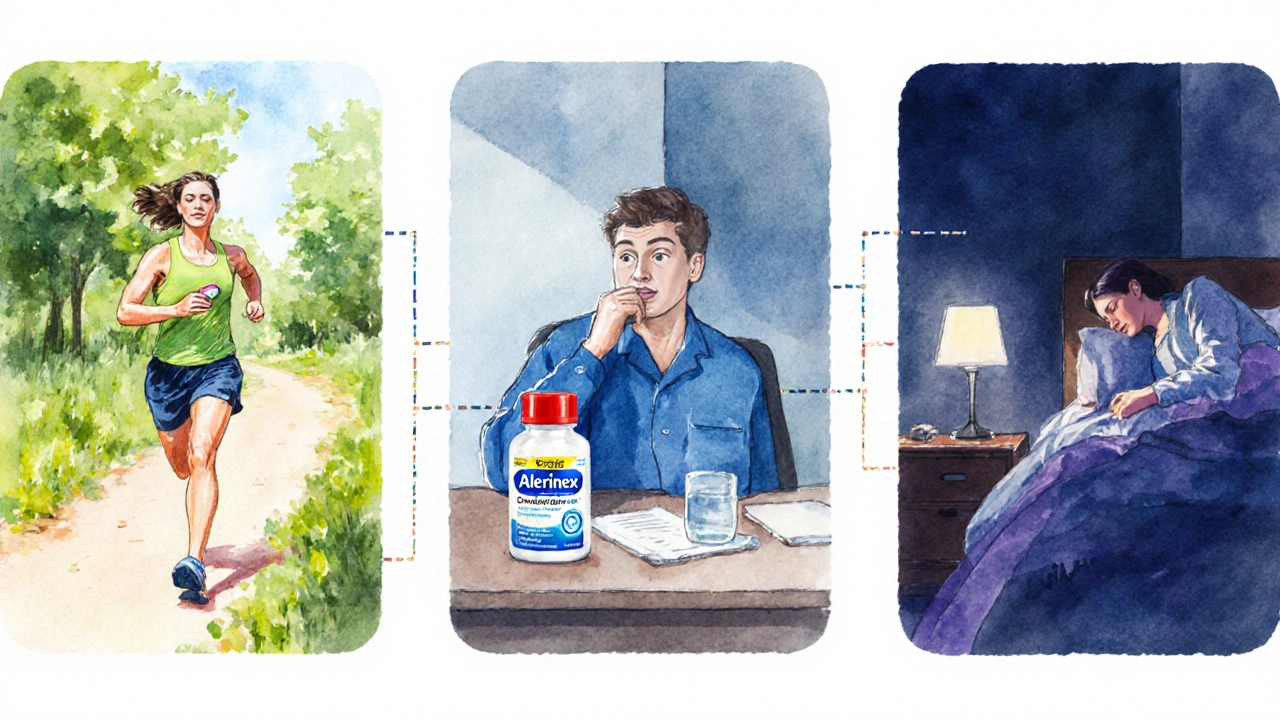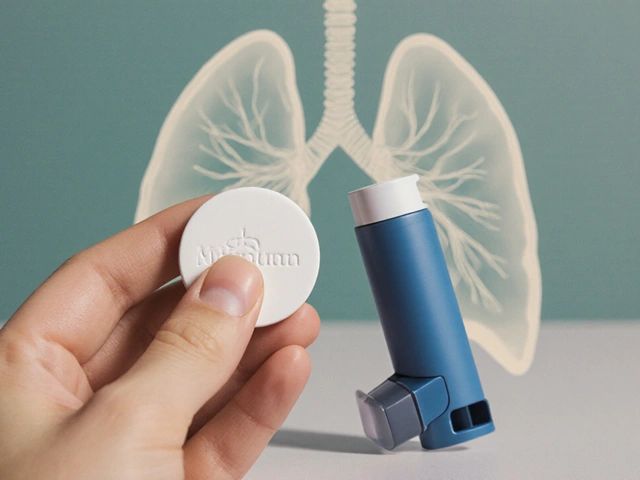Antihistamine Selector
Select Your Preferences
Recommended Antihistamine:
When you’re battling sneezing, itchy eyes, or a runny nose, the first question is usually: which antihistamine will actually calm you down without making you feel drowsy? Clarinex (the brand name for desloratadine) is a popular choice, but it’s not the only player on the market. This guide lines up Clarinex against the most common over‑the‑counter options so you can see which one fits your lifestyle, symptom profile, and budget.
Quick Takeaways
- Clarinex (desloratadine) is a third‑generation antihistamine with low sedation risk.
- Loratadine (Claritin) offers similar effectiveness at a lower price but works a bit slower.
- Cetirizine (Zyrtec) is the most potent for severe symptoms but may cause mild drowsiness.
- Fexofenadine (Allegra) works fastest and stays non‑sedating, but its duration is shorter.
- Diphenhydramine (Benadryl) is a first‑generation antihistamine best reserved for short‑term use due to strong sedation.
What Is Desloratadine?
Desloratadine is a third‑generation, non‑sedating antihistamine that blocks H1 receptors, preventing histamine from triggering allergy symptoms. Marketed under the brand name Clarinex, it was approved by the FDA in 2007 and has become a go‑to option for adults who need all‑day relief without feeling groggy.
How Does Clarinex Compare to Other Antihistamines?
To make a fair comparison, we’ll look at four key factors: onset of action, duration of effect, sedation risk, and price. These criteria match what most sufferers care about - how quickly they feel better, how long the relief lasts, whether they can stay alert, and what they’ll spend.
Side‑by‑Side Comparison Table
| Antihistamine | Brand (US) | Generation | Typical Dose | Onset | Duration | Sedation Risk | Best For |
|---|---|---|---|---|---|---|---|
| Desloratadine | Clarinex | 3rd | 5mg once daily | 1hour | 24hours | Low | All‑day, non‑sedating relief |
| Loratadine | Claritin | 2nd | 10mg once daily | 1-3hours | 24hours | Low | Budget‑friendly, mild symptoms |
| Cetirizine | Zyrtec | 2nd | 10mg once daily | 30minutes | 24hours | Moderate | Severe or chronic allergies |
| Fexofenadine | Allegra | 2nd | 180mg once daily (or 60mg twice daily) | 15-30minutes | 12-24hours | Low | Fast relief, non‑sedating |
| Diphenhydramine | Benadryl | 1st | 25-50mg every 4-6hours | 15minutes | 4-6hours | High | Acute flare‑ups, night‑time use |

Deep Dive Into Each Option
Clarinex (Desloratadine)
Desloratadine is essentially loratadine’s metabolite, meaning the body converts loratadine into desloratadine during digestion. By delivering the active form directly, Clarinex offers a cleaner pharmacokinetic profile - it reaches peak blood concentration faster and has slightly less inter‑patient variability. Clinical trials show a 96% reduction in nasal congestion after 24hours of a single dose, and the drug rarely crosses the blood‑brain barrier, which is why the sedation rating is consistently low.
Side effects are mild: occasional dry mouth or headache in less than 5% of users. Because it’s non‑sedating, it’s safe for people who need to drive or operate machinery.
Loratadine (Claritin)
Loratadine is the predecessor of desloratadine. It’s a second‑generation antihistamine that shares the same low‑sedation profile, but its onset can be slower due to the metabolic step required to convert it into desloratadine in the liver. The drug is available in both tablet and syrup forms, making it a family‑friendly option.
Price is the biggest advantage - generic loratadine costs roughly half of branded Clarinex. In head‑to‑head studies, both achieve comparable 24‑hour relief, though some patients notice a slight edge in symptom control with desloratadine.
Cetirizine (Zyrtec)
Cetirizine is known for being the strongest second‑generation antihistamine on the market. Its higher affinity for H1 receptors translates into faster and more complete symptom suppression, especially for nasal congestion and itchy eyes. The trade‑off is a modest sedation risk - about 10% of users report mild drowsiness, particularly at higher doses.
People with chronic allergic rhinitis often prefer cetirizine because it keeps symptoms at bay even during peak pollen weeks. If you can tolerate a little tiredness, it may be the most reliable daily shield.
Fexofenadine (Allegra)
Fexofenadine is a third‑generation antihistamine that prides itself on being 100% non‑sedating. It works quickly - many users feel relief within 30minutes. However, its duration can vary: a single 180mg dose lasts roughly 12hours, so some people split the dose twice a day for consistent coverage.
Because fexofenadine is less lipophilic, it doesn’t cross into the brain, eliminating drowsiness. It’s also the preferred choice for athletes who need rapid, clean clearance before competitions.
Diphenhydramine (Benadryl)
Diphenhydramine is a first‑generation antihistamine that was the standard before the newer generations arrived. It blocks H1 receptors forcefully, providing immediate relief, but it also binds to muscarinic receptors, causing classic anticholinergic side effects: dry mouth, blurred vision, and pronounced sedation.
Because of these effects, health professionals recommend using diphenhydramine only for short bursts - for example, a sudden allergy attack before a flight or an occasional night‑time itch that would otherwise keep you awake.
Choosing the Right Antihistamine for You
Here’s a quick decision tree you can follow:
- If you need all‑day, non‑sedating relief and are okay paying a premium, go with Clarinex.
- If cost is a major factor and you can tolerate a slightly slower onset, choose generic Loratadine.
- If you have severe or stubborn symptoms and don’t mind mild drowsiness, Cetirizine is a solid pick.
- If you want the fastest kick‑in with zero sedation, especially for outdoor activities, try Fexofenadine.
- If you need an immediate solution for a one‑off flare‑up or to help you sleep, Diphenhydramine fits the bill - but limit use to a few nights.
Also consider any pre‑existing conditions. People with glaucoma, prostate enlargement, or certain heart problems should avoid diphenhydramine because of its anticholinergic load. Those on chronic medication regimens may want to check for drug interactions - fexofenadine’s absorption can be reduced by fruit juices, for instance.
Common Questions About Antihistamines
Below are the questions we get most often from folks trying to tame their allergies.
Frequently Asked Questions
Can I take Clarinex with other allergy medicines?
Yes, but only if the other product is a nasal spray or eye drops that target a different pathway. Combining two oral antihistamines can increase side‑effects without improving relief.
Is it safe to use Clarinex during pregnancy?
Desloratadine is classified as Pregnancy Category B in the U.S., meaning animal studies haven’t shown risk, but there are limited human data. Always discuss with your obstetrician before starting any new medication.
How long does it take for Clarinex to start working?
Most adults notice symptom reduction within 1hour, with full effect usually reached by the 3‑hour mark.
Can I switch from loratadine to Clarinex without a wash‑out period?
Yes. Both drugs work on the same receptor, so you can simply replace your daily loratadine tablet with a Clarinex tablet.
What should I do if I miss a dose of Clarinex?
Take the missed dose as soon as you remember, unless it’s almost time for the next one. In that case, skip the missed dose - don’t double‑up.
Potential Pitfalls & How to Avoid Them
- Mixing sedating antihistamines - taking diphenhydramine with cetirizine can push drowsiness to unsafe levels.
- Skipping meals - some antihistamines (especially fexofenadine) need food for optimal absorption.
- Ignoring drug interactions - antacids, certain antibiotics, and grapefruit juice can affect how quickly your body clears the medication.
- Not accounting for seasonal peaks - during high pollen weeks, a more potent antihistamine like cetirizine may prevent breakthrough symptoms that a milder option would miss.

Bottom Line: Which Antihistamine Wins?
There’s no one‑size‑fits‑all answer. If you value a predictable 24‑hour window with virtually no sleepiness, Clarinex is hard to beat. If you’re looking for a wallet‑friendly daily pill, generic loratadine does the job with just a tiny trade‑off in speed. For power users battling severe, chronic allergies, cetirizine’s punchy effect often outweighs its mild sedation. Athletes and anyone who needs rapid, clean relief should reach for fexofenadine, while diphenhydramine remains the emergency‑room rescue for short‑term flare‑ups.
Try the option that matches your priority, track how you feel for a week, and adjust if needed. Most importantly, keep an eye on any side effects - if a medication makes you feel off, switch to another. Your nose, eyes, and energy level will thank you.




Comments
16 Comments
Jason Divinity
When parsing the comparative matrix of antihistamines, one discerns an elegant hierarchy: Clarinex occupies the apex of non‑sedative efficacy, while Loratadine languishes in the budget‑conscious stratum, and Cetirizine thrusts itself forward with aggressive receptor affinity, albeit at the modest cost of occasional drowsiness. The pharmacokinetic nuance-direct delivery of desloratadine versus hepatic conversion of loratadine-bestows a swifter therapeutic onset upon Clarinex, a fact that should not be dismissed by the casual consumer. Moreover, the negligible central nervous system penetration of Desloratadine aligns with a philosophical pursuit of unimpeded cognition during allergic siege. In sum, the choice hinges upon a triad of variables: desired rapidity, tolerance for sedation, and fiscal flexibility, each demanding rigorous self‑assessment.
andrew parsons
Indeed-The nuanced distinctions among these agents merit meticulous scrutiny!!! 😉 Clarinex delivers consistent 24‑hour relief with minimal drowsiness; Loratadine offers a cost‑effective alternative, albeit with a slightly delayed onset; Cetirizine provides potent symptom suppression but may provoke mild somnolence in up to ten percent of users!!! Consider your daily schedule, your budgetary constraints, and your tolerance for sedation before finalizing your selection!!!
Sarah Arnold
Here’s a quick practical tip 😊: if you’re an athlete needing a clean slate before competition, Fexofenadine is your go‑to-zero sedation and rapid onset. For everyday office workers who can’t afford a dip in focus, stick with Clarinex or generic Loratadine depending on price tolerance. Remember to take Fexofenadine with food; its absorption drops with grapefruit juice. 👍
Rajat Sangroy
Don’t waste time debating the “best” pill-just match the drug to the symptom profile! If you’re battling severe nasal congestion and can handle a touch of fatigue, Cetirizine smashes it. If you need all‑day clarity for a high‑stakes presentation, Clarinex is worth the premium. And for those on a shoestring budget, Loratadine does a respectable job without breaking the bank. Choose wisely and stop letting allergies dictate your day.
dany prayogo
Ah, the never‑ending quest for the perfect antihistamine-one might as well search for the Holy Grail while sipping a lukewarm latte and listening to the endless whine of the office printer. Let us embark on a grand, fifteen‑sentence odyssey through the labyrinth of allergic remedies, where every turn reveals a new nuance that could, in theory, change the very fabric of your nasal passages. First, consider Clarinex, the aristocratic heir to Loratadine’s throne, boasting a refined, non‑sedating pedigree that whispers promises of uninterrupted productivity. Yet, its price tag, akin to a boutique espresso, may leave the fiscally‑conscious bereft of coin. Next, we encounter Cetirizine, the powerhouse brawler of the second‑generation cohort, delivering rapid knock‑out blows to histamine but occasionally leaving you with the after‑taste of mild drowsiness-an insomniac’s nightmare and a daytime driver’s hazard. Then enters Fexofenadine, the sprinter, whose blitz through the bloodstream is as swift as a cheetah, promising relief in under half an hour, though its half‑life may demand a second round for those with marathon‑length allergies. And who could forget the venerable Benadryl, the seasoned veteran that, despite its antiquated first‑generation reputation, still fights valiantly in acute flare‑ups, albeit at the cost of turning you into a human pillow. In the grand tapestry of antihistamine choice, one must weigh the threads of onset, duration, sedation, and cost, each tugging at the fabric of daily life. If you are a night‑owl needing to stay awake, shun Benadryl; if you are a budget‑tight student, embrace Loratadine; if you cherish relentless alertness, cling to Clarinex. Ultimately, the decision rests upon your own allergic destiny, and no single pill can claim universal supremacy. So, dear reader, arm yourself with this knowledge, experiment responsibly, and may your sneezes be forever silenced.
Wilda Prima Putri
Sure, because picking a pill is just that simple.
Edd Dan
Just a heads‑up: mixing Benadryl with cetirizin can make you feel like you're walking through syrup. Keep them separate for best results.
Jaime Torres
Meh, just buy the cheapest generic.
Wayne Adler
When you think about the ontological impact of suppressing histamine, you realize that each antihistamine is a philosophical stance: Clarinex declares an allegiance to lucid consciousness, while Benadryl accepts the surrender to somnolence as an inevitable trade‑off. Yet, the pragmatic mind must also recognize the sheer biochemical elegance of targeting H1 receptors without collateral cholinergic chaos. In short, pick the drug that aligns with both your metaphysical preferences and your morning commute schedule.
Shane Hall
Listen up, team! If you're gearing up for a long day of presentations, the drama of a sudden sneeze is the worst villain. Clarinex swoops in like a silent superhero-no drowsy side‑effects, 24‑hour coverage, and it doesn't steal the spotlight. For those on a tighter budget, Loratadine is the trusty sidekick that still saves the day without draining your wallet. And remember: consistency is key-take your chosen antihistamine at the same time each day for optimal performance. Stay vigilant, stay clear‑headed, and let nothing block your path to victory!
Chelsea Kerr
Philosophically speaking, the choice of antihistamine mirrors our quest for balance 🌿-seek relief without compromising consciousness, and you'll find harmony. 🌟
Tom Becker
Did you ever notice how the pharma giants hide the real side‑effects behind a veil of “safe for all”? Wake up, they’re pumping chemicals into our bloodstream while the media distracts us with cat videos. Stay alert, question everything, and maybe skip the meds altogether. The truth is out there, just not in the glossy ads.
Laura Sanders
While the layperson flutters between brand names, the discerning reader knows that the generic compounds are chemically identical, rendering brand loyalty an exercise in futility. One should allocate resources to empirically proven interventions rather than succumbing to marketing hype.
Jai Patel
Hey buddy, don't let allergies hold you back! Grab the fast‑acting Allegra if you're hitting the gym, or splurge on Clarinex for that all‑day focus. Your health, your rules-keep crushing it!
Zara @WSLab
Great rundown! 🌟 Remember, staying hydrated can boost any antihistamine’s effectiveness. Keep sipping water and you’ll feel the difference.
Randy Pierson
In summation, the optimal antihistamine is a personalized selection, a mosaic of efficacy, cost, and lifestyle-choose wisely and breathe easy.
Write a comment